steering MAZDA MODEL TRIBUTE 2008 (in English) Owner's Manual
[x] Cancel search | Manufacturer: MAZDA, Model Year: 2008, Model line: MODEL TRIBUTE, Model: MAZDA MODEL TRIBUTE 2008Pages: 288, PDF Size: 3.9 MB
Page 183 of 288
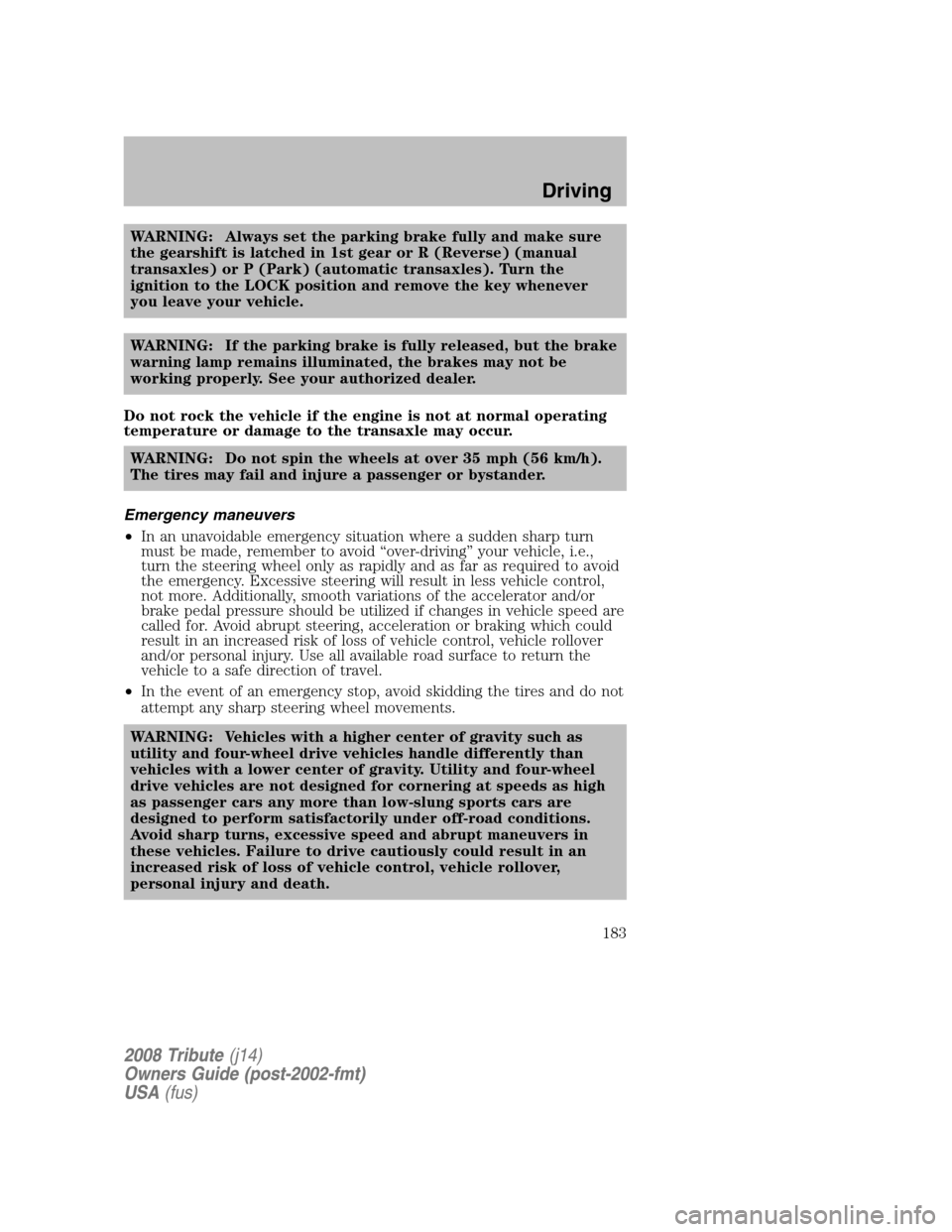
WARNING: Always set the parking brake fully and make sure
the gearshift is latched in 1st gear or R (Reverse) (manual
transaxles) or P (Park) (automatic transaxles). Turn the
ignition to the LOCK position and remove the key whenever
you leave your vehicle.
WARNING: If the parking brake is fully released, but the brake
warning lamp remains illuminated, the brakes may not be
working properly. See your authorized dealer.
Do not rock the vehicle if the engine is not at normal operating
temperature or damage to the transaxle may occur. WARNING: Do not spin the wheels at over 35 mph (56 km/h).
The tires may fail and injure a passenger or bystander.
Emergency maneuvers
• In an unavoidable emergency situation where a sudden sharp turn
must be made, remember to avoid “over-driving” your vehicle, i.e.,
turn the steering wheel only as rapidly and as far as required to avoid
the emergency. Excessive steering will result in less vehicle control,
not more. Additionally, smooth variations of the accelerator and/or
brake pedal pressure should be utilized if changes in vehicle speed are
called for. Avoid abrupt steering, acceleration or braking which could
result in an increased risk of loss of vehicle control, vehicle rollover
and/or personal injury. Use all available road surface to return the
vehicle to a safe direction of travel.
• In the event of an emergency stop, avoid skidding the tires and do not
attempt any sharp steering wheel movements.
WARNING: Vehicles with a higher center of gravity such as
utility and four-wheel drive vehicles handle differently than
vehicles with a lower center of gravity. Utility and four-wheel
drive vehicles are not designed for cornering at speeds as high
as passenger cars any more than low-slung sports cars are
designed to perform satisfactorily under off-road conditions.
Avoid sharp turns, excessive speed and abrupt maneuvers in
these vehicles. Failure to drive cautiously could result in an
increased risk of loss of vehicle control, vehicle rollover,
personal injury and death.
2008 Tribute (j14)
Owners Guide (post-2002-fmt)
USA (fus)
Driving
183
Page 184 of 288
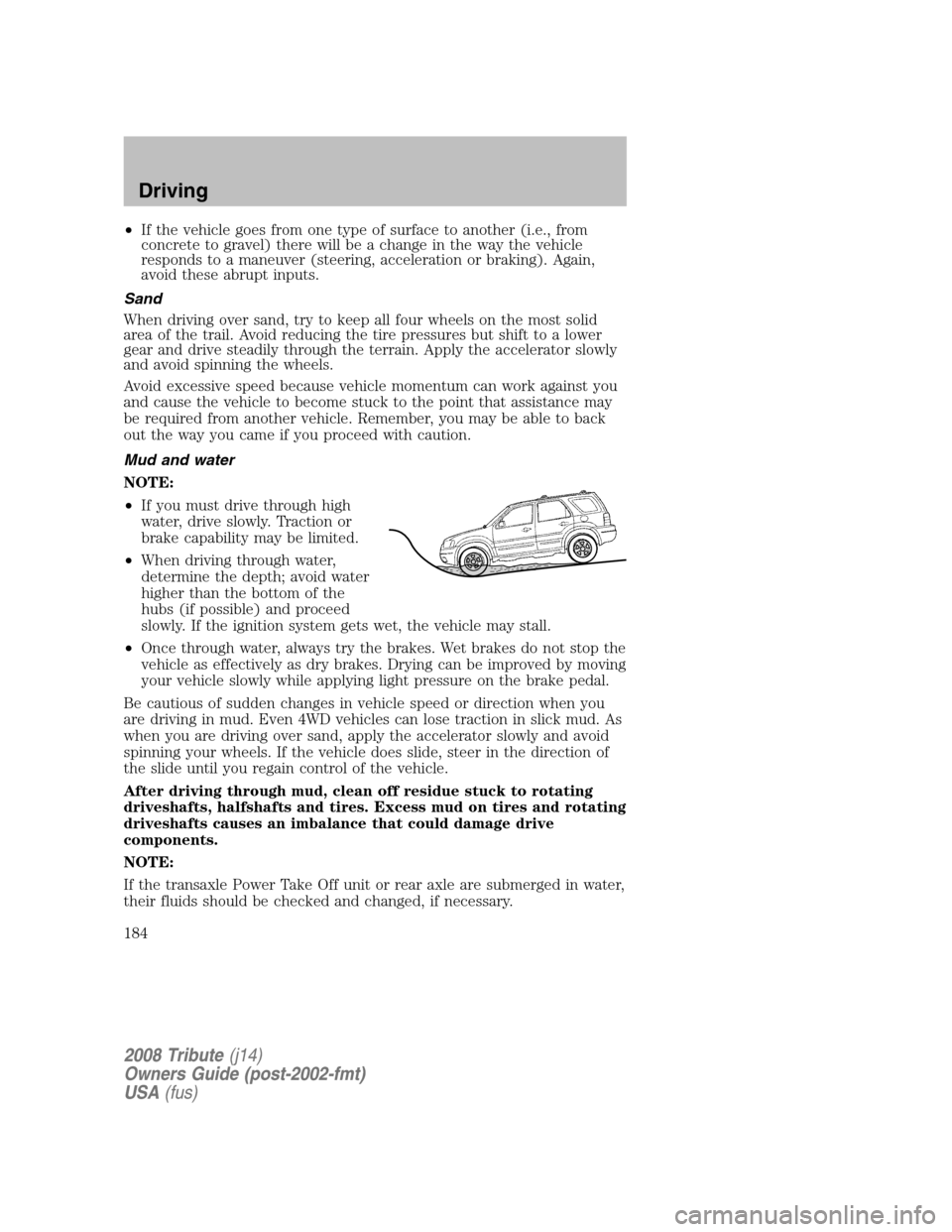
•If the vehicle goes from one type of surface to another (i.e., from
concrete to gravel) there will be a change in the way the vehicle
responds to a maneuver (steering, acceleration or braking). Again,
avoid these abrupt inputs.
Sand
When driving over sand, try to keep all four wheels on the most solid
area of the trail. Avoid reducing the tire pressures but shift to a lower
gear and drive steadily through the terrain. Apply the accelerator slowly
and avoid spinning the wheels.
Avoid excessive speed because vehicle momentum can work against you
and cause the vehicle to become stuck to the point that assistance may
be required from another vehicle. Remember, you may be able to back
out the way you came if you proceed with caution.
Mud and water
NOTE:
• If you must drive through high
water, drive slowly. Traction or
brake capability may be limited.
• When driving through water,
determine the depth; avoid water
higher than the bottom of the
hubs (if possible) and proceed
slowly. If the ignition system gets wet, the vehicle may stall.
• Once through water, always try the brakes. Wet brakes do not stop the
vehicle as effectively as dry brakes. Drying can be improved by moving
your vehicle slowly while applying light pressure on the brake pedal.
Be cautious of sudden changes in vehicle speed or direction when you
are driving in mud. Even 4WD vehicles can lose traction in slick mud. As
when you are driving over sand, apply the accelerator slowly and avoid
spinning your wheels. If the vehicle does slide, steer in the direction of
the slide until you regain control of the vehicle.
After driving through mud, clean off residue stuck to rotating
driveshafts, halfshafts and tires. Excess mud on tires and rotating
driveshafts causes an imbalance that could damage drive
components.
NOTE:
If the transaxle Power Take Off unit or rear axle are submerged in water,
their fluids should be checked and changed, if necessary.
2008 Tribute (j14)
Owners Guide (post-2002-fmt)
USA (fus)
Driving
184
Page 186 of 288
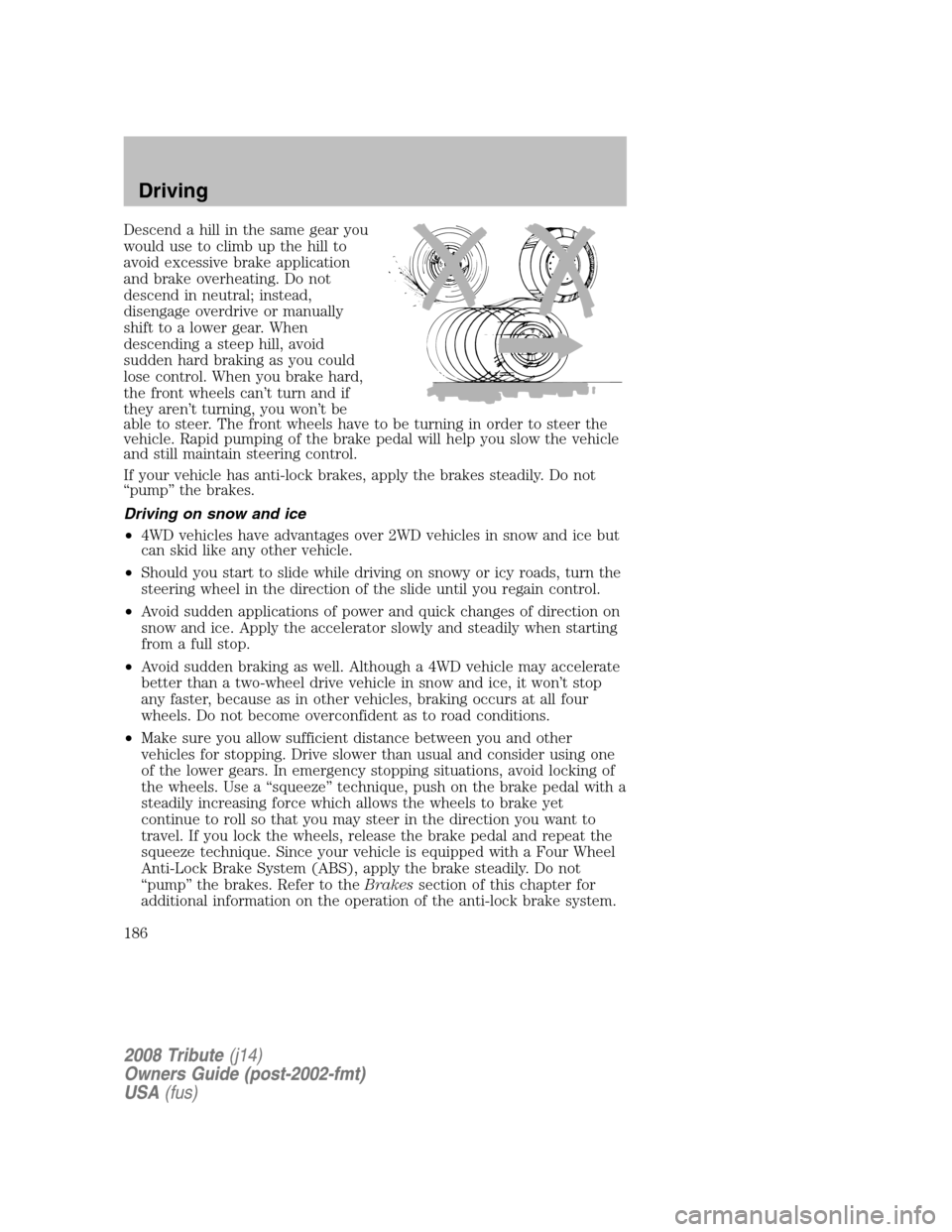
Descend a hill in the same gear you
would use to climb up the hill to
avoid excessive brake application
and brake overheating. Do not
descend in neutral; instead,
disengage overdrive or manually
shift to a lower gear. When
descending a steep hill, avoid
sudden hard braking as you could
lose control. When you brake hard,
the front wheels can’t turn and if
they aren’t turning, you won’t be
able to steer. The front wheels have to be turning in order to steer the
vehicle. Rapid pumping of the brake pedal will help you slow the vehicle
and still maintain steering control.
If your vehicle has anti-lock brakes, apply the brakes steadily. Do not
“pump” the brakes.
Driving on snow and ice
• 4WD vehicles have advantages over 2WD vehicles in snow and ice but
can skid like any other vehicle.
• Should you start to slide while driving on snowy or icy roads, turn the
steering wheel in the direction of the slide until you regain control.
• Avoid sudden applications of power and quick changes of direction on
snow and ice. Apply the accelerator slowly and steadily when starting
from a full stop.
• Avoid sudden braking as well. Although a 4WD vehicle may accelerate
better than a two-wheel drive vehicle in snow and ice, it won’t stop
any faster, because as in other vehicles, braking occurs at all four
wheels. Do not become overconfident as to road conditions.
• Make sure you allow sufficient distance between you and other
vehicles for stopping. Drive slower than usual and consider using one
of the lower gears. In emergency stopping situations, avoid locking of
the wheels. Use a “squeeze” technique, push on the brake pedal with a
steadily increasing force which allows the wheels to brake yet
continue to roll so that you may steer in the direction you want to
travel. If you lock the wheels, release the brake pedal and repeat the
squeeze technique. Since your vehicle is equipped with a Four Wheel
Anti-Lock Brake System (ABS), apply the brake steadily. Do not
“pump” the brakes. Refer to the Brakessection of this chapter for
additional information on the operation of the anti-lock brake system.
2008 Tribute (j14)
Owners Guide (post-2002-fmt)
USA (fus)
Driving
186
Page 187 of 288

•4WD vehicles should be driven with traction devices as referred to in
Using snow tires and traction devices in theTires, Wheels and
Loading chapter.
Maintenance and Modifications
The suspension and steering systems on your vehicle have been designed
and tested to provide predictable performance whether loaded or empty
and durable load carrying capability. For this reason, Mazda Motor
Corporation strongly recommends that you do not make modifications
such as adding or removing parts (such as lift kits or stabilizer bars) or
by using replacement parts not equivalent to the original factory
equipment.
Any modifications to a vehicle that raise the center of gravity can make
it more likely the vehicle will roll over as a result of a loss of control.
Mazda Motor Corporation recommends that caution be used with any
vehicle equipped with a high load or device (such as ladder racks or
pickup box cover).
Failure to maintain your vehicle properly may void the warranty, increase
your repair cost, reduce vehicle performance and operational capabilities
and adversely affect driver and passenger safety. Frequent inspection of
vehicle chassis components is recommended if the vehicle is subjected to
heavy off-road usage.
DRIVING THROUGH WATER
If driving through deep or standing
water is unavoidable, proceed very
slowly especially when the depth is
not known. Never drive through
water that is higher than the bottom
of the wheel rims (for cars) or the
bottom of the hubs (for trucks).
When driving through water, traction or brake capability may be limited.
Also, water may enter your engine’s air intake and severely damage your
engine or your vehicle may stall. Driving through deep water where
the transmission vent tube is submerged may allow water into the
transmission and cause internal transmission damage.
Once through the water, always dry the brakes by moving your
vehicle slowly while applying light pressure on the brake pedal.
Wet brakes do not stop the vehicle as quickly as dry brakes.
2008 Tribute (j14)
Owners Guide (post-2002-fmt)
USA (fus)
Driving
187
Page 188 of 288

HAZARD FLASHER CONTROL
The hazard flasher is located on the
steering column, just behind the
steering wheel. The hazard flashers
will operate when the ignition is in
any position or if the key is not in
the ignition.
Push in the flasher control and all
front and rear direction signals will
flash. Press the flasher control again
to turn them off. Use it when your
vehicle is disabled and is creating a
safety hazard for other motorists.
Note: With extended use, the flasher may run down your battery.
2008 Tribute (j14)
Owners Guide (post-2002-fmt)
USA (fus)
Roadside Emergencies
188
Page 192 of 288
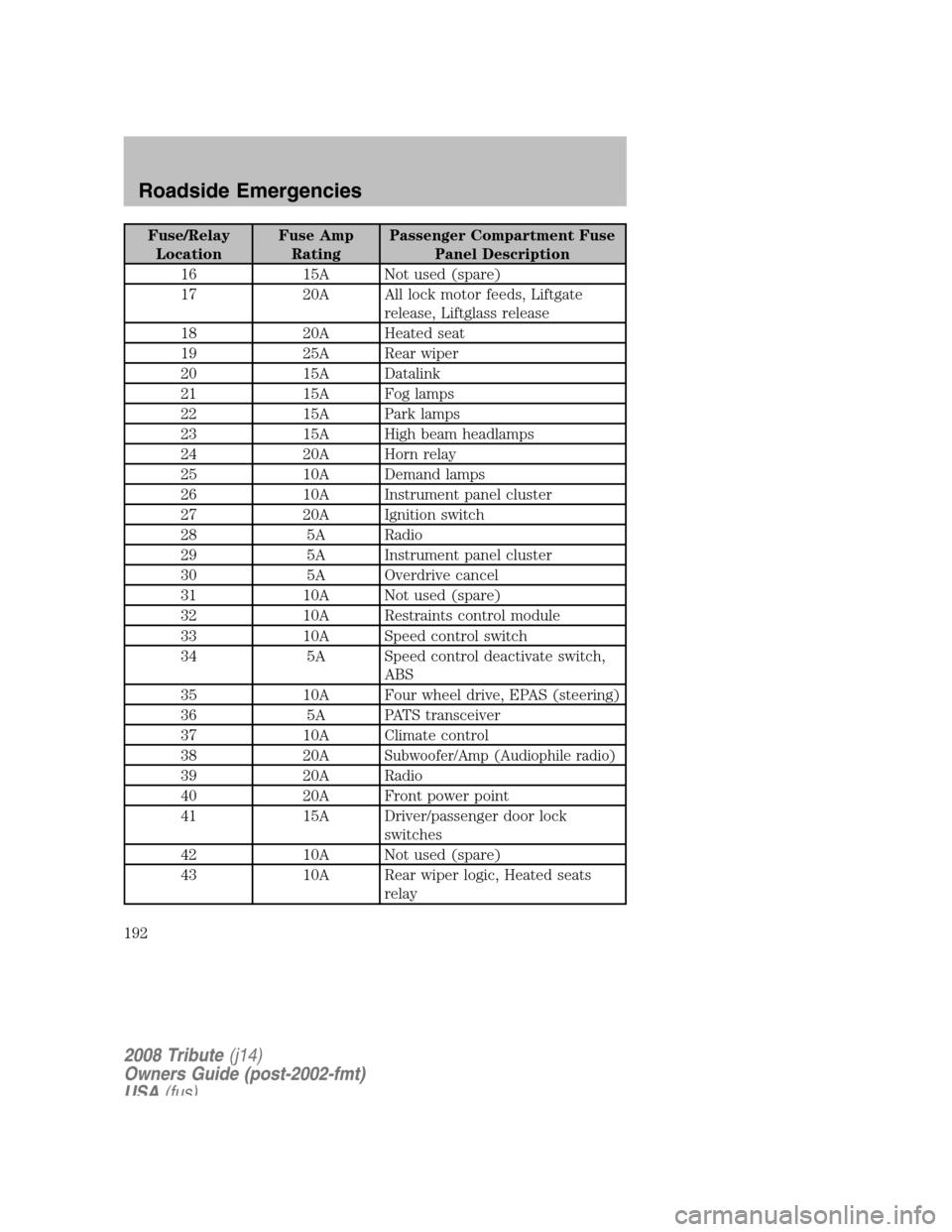
Fuse/Relay Location Fuse Amp
Rating Passenger Compartment Fuse
Panel Description
16 15A Not used (spare)
17 20A All lock motor feeds, Liftgate release, Liftglass release
18 20A Heated seat
19 25A Rear wiper
20 15A Datalink
21 15A Fog lamps
22 15A Park lamps
23 15A High beam headlamps
24 20A Horn relay
25 10A Demand lamps
26 10A Instrument panel cluster
27 20A Ignition switch
28 5A Radio
29 5A Instrument panel cluster
30 5A Overdrive cancel
31 10A Not used (spare)
32 10A Restraints control module
33 10A Speed control switch
34 5A Speed control deactivate switch, ABS
35 10A Four wheel drive, EPAS (steering)
36 5A PATS transceiver
37 10A Climate control
38 20A
Subwoofer/Amp (Audiophile radio)
39 20A Radio
40 20A Front power point
41 15A Driver/passenger door lock switches
42 10A Not used (spare)
43 10A Rear wiper logic, Heated seats relay
2008 Tribute (j14)
Owners Guide (post-2002-fmt)
USA (fus)
Roadside Emergencies
192
Page 196 of 288

CHANGING A FLAT TIRE
If you get a flat tire while driving:
• do not brake heavily.
• gradually decrease the vehicle’s speed.
• hold the steering wheel firmly.
• slowly move to a safe place on the side of the road.
Your vehicle may be equipped with a conventional spare tire that is
different in one or more of the following: type, brand, size, speed rating
and tread design. If this is the case, this dissimilar spare tire is still rated
for your vehicle loads (GAWR and GVWR). This temporary spare tire is
not equipped with a Tire Pressure Monitor System (TPMS) sensor.
Note: The tire pressure monitoring system (TPMS) indicator light will
illuminate when the spare is in use. To restore the full functionality of
the TPMS system, all road wheels equipped with the tire pressure
monitoring sensors must be mounted on the vehicle.
Have a flat tire serviced by an authorized dealer in order to prevent
damage to the TPMS sensor, refer to Tire Pressure Monitoring System
(TPMS) in theTires, Wheels, and Loading chapter. Replace the spare
tire with a road tire as soon as possible. During repairing or replacing of
the flat tire, have the authorized dealer inspect the TPMS sensor for
damage.
WARNING: The use of tire sealants may damage your tires. The
use of tire sealants may also damage your Tire Pressure
Monitoring System and should not be used.
WARNING: Refer to Tire Pressure Monitoring System (TPMS)
in the Tire, Wheels and Loading chapter for important
information. If the tire pressure monitor sensor becomes
damaged, it will no longer function.
Dissimilar spare tire/wheel information WARNING: Failure to follow these guidelines could result in an
increased risk of loss of vehicle control, injury or death.
2008 Tribute (j14)
Owners Guide (post-2002-fmt)
USA (fus)
Roadside Emergencies
196
Page 229 of 288
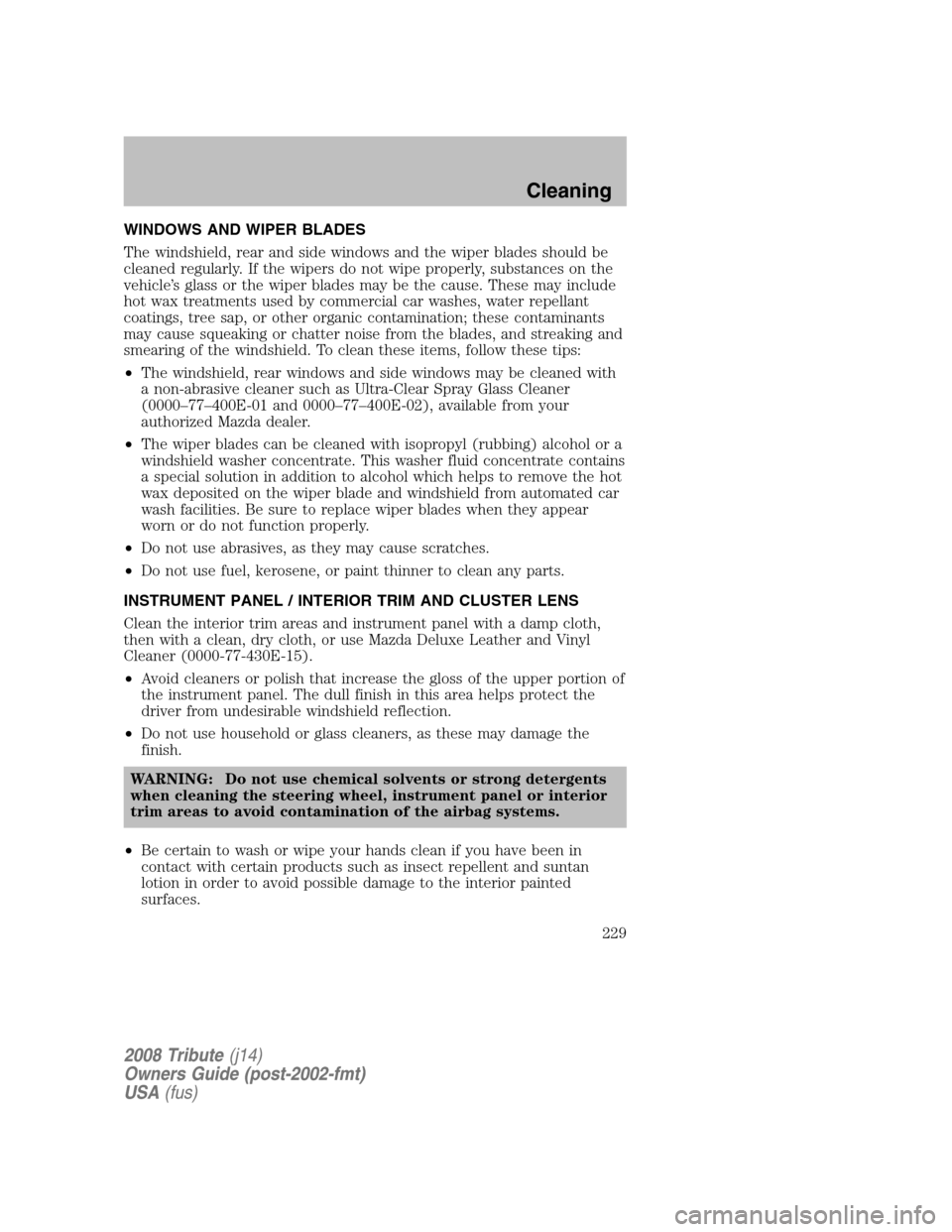
WINDOWS AND WIPER BLADES
The windshield, rear and side windows and the wiper blades should be
cleaned regularly. If the wipers do not wipe properly, substances on the
vehicle’s glass or the wiper blades may be the cause. These may include
hot wax treatments used by commercial car washes, water repellant
coatings, tree sap, or other organic contamination; these contaminants
may cause squeaking or chatter noise from the blades, and streaking and
smearing of the windshield. To clean these items, follow these tips:
• The windshield, rear windows and side windows may be cleaned with
a non-abrasive cleaner such as Ultra-Clear Spray Glass Cleaner
(0000–77–400E-01 and 0000–77–400E-02), available from your
authorized Mazda dealer.
• The wiper blades can be cleaned with isopropyl (rubbing) alcohol or a
windshield washer concentrate. This washer fluid concentrate contains
a special solution in addition to alcohol which helps to remove the hot
wax deposited on the wiper blade and windshield from automated car
wash facilities. Be sure to replace wiper blades when they appear
worn or do not function properly.
• Do not use abrasives, as they may cause scratches.
• Do not use fuel, kerosene, or paint thinner to clean any parts.
INSTRUMENT PANEL / INTERIOR TRIM AND CLUSTER LENS
Clean the interior trim areas and instrument panel with a damp cloth,
then with a clean, dry cloth, or use Mazda Deluxe Leather and Vinyl
Cleaner (0000-77-430E-15).
• Avoid cleaners or polish that increase the gloss of the upper portion of
the instrument panel. The dull finish in this area helps protect the
driver from undesirable windshield reflection.
• Do not use household or glass cleaners, as these may damage the
finish.
WARNING: Do not use chemical solvents or strong detergents
when cleaning the steering wheel, instrument panel or interior
trim areas to avoid contamination of the airbag systems.
• Be certain to wash or wipe your hands clean if you have been in
contact with certain products such as insect repellent and suntan
lotion in order to avoid possible damage to the interior painted
surfaces.
2008 Tribute (j14)
Owners Guide (post-2002-fmt)
USA (fus)
Cleaning
229
Page 234 of 288
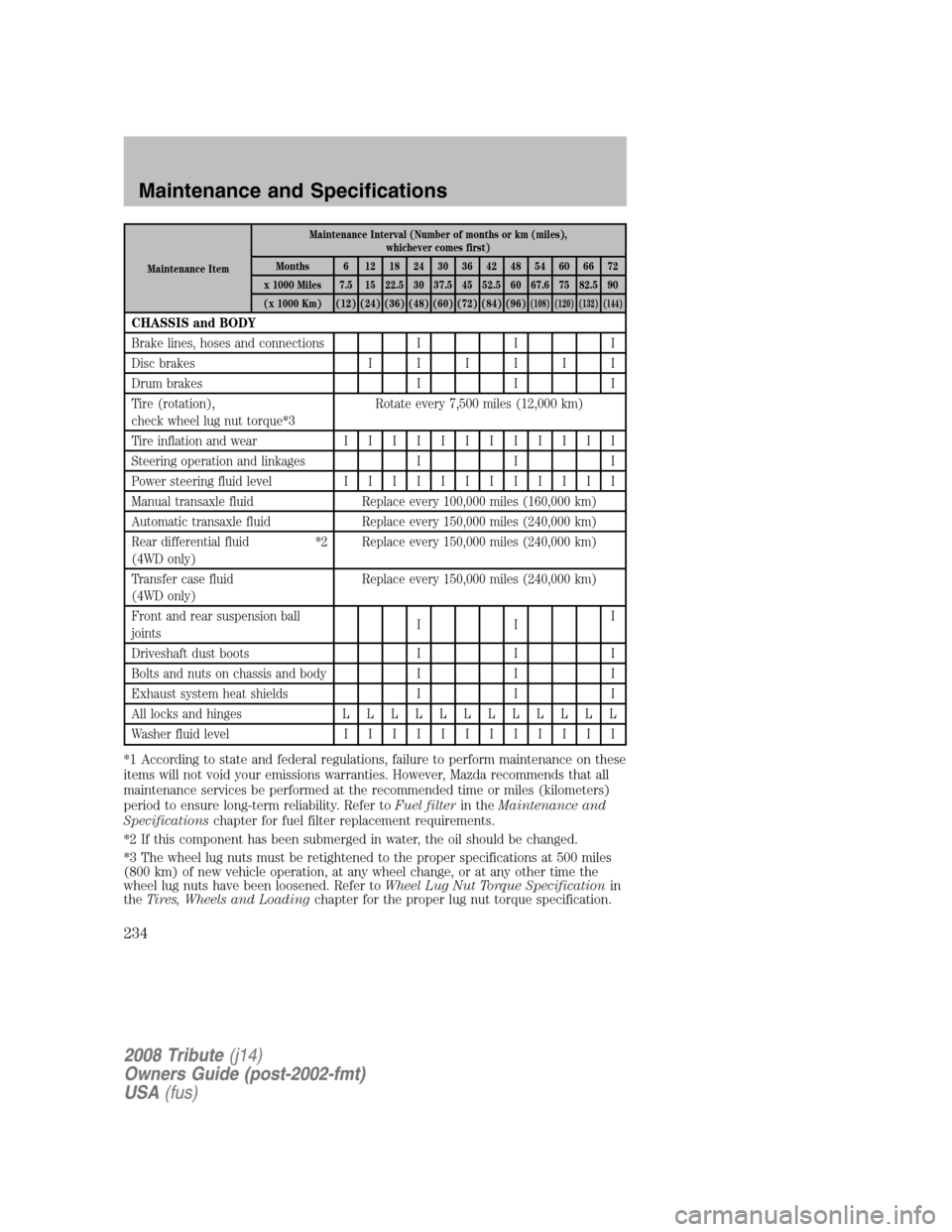
Maintenance Item Maintenance Interval (Number of months or km (miles),
whichever comes first)
Months 6 12 18 24 30 36 42 48 54 60 66 72
x 1000 Miles 7.5 15 22.5 30 37.5 45 52.5 60 67.6 75 82.5 90
(x 1000 Km) (12) (24) (36) (48) (60) (72) (84) (96)
(108) (120) (132) (144)
CHASSIS and BODY
Brake lines, hoses and connections I I I
Disc brakes IIIIII
Drum brakes I I I
Tire (rotation),
check wheel lug nut torque*3 Rotate every 7,500 miles (12,000 km)
Tire inflation and wear IIIIIIIIIIII
Steering operation and linkages I I I
Power steering fluid level IIIIIIIIIIII
Manual transaxle fluid Replace every 100,000 miles (160,000 km)
Automatic transaxle fluid Replace every 150,000 miles (240,000 km)
Rear differential fluid
(4WD only) *2 Replace every 150,000 miles (240,000 km)
Transfer case fluid
(4WD only) Replace every 150,000 miles (240,000 km)
Front and rear suspension ball
joints III
Driveshaft dust boots I I I
Bolts and nuts on chassis and body I I I
Exhaust system heat shields I I I
All locks and hinges L L L L L L L L L L L L
Washer fluid level IIIIIIIIIIII
*1 According to state and federal regulations, failure to perform maintenance on these
items will not void your emissions warranties. However, Mazda recommends that all
maintenance services be performed at the recommended time or miles (kilometers)
period to ensure long-term reliability. Refer to Fuel filterin theMaintenance and
Specifications chapter for fuel filter replacement requirements.
*2 If this component has been submerged in water, the oil should be changed.
*3 The wheel lug nuts must be retightened to the proper specifications at 500 miles
(800 km) of new vehicle operation, at any wheel change, or at any other time the
wheel lug nuts have been loosened. Refer to Wheel Lug Nut Torque Specificationin
the Tires, Wheels and Loading chapter for the proper lug nut torque specification.
2008 Tribute(j14)
Owners Guide (post-2002-fmt)
USA (fus)
Maintenance and Specifications
234
Page 236 of 288
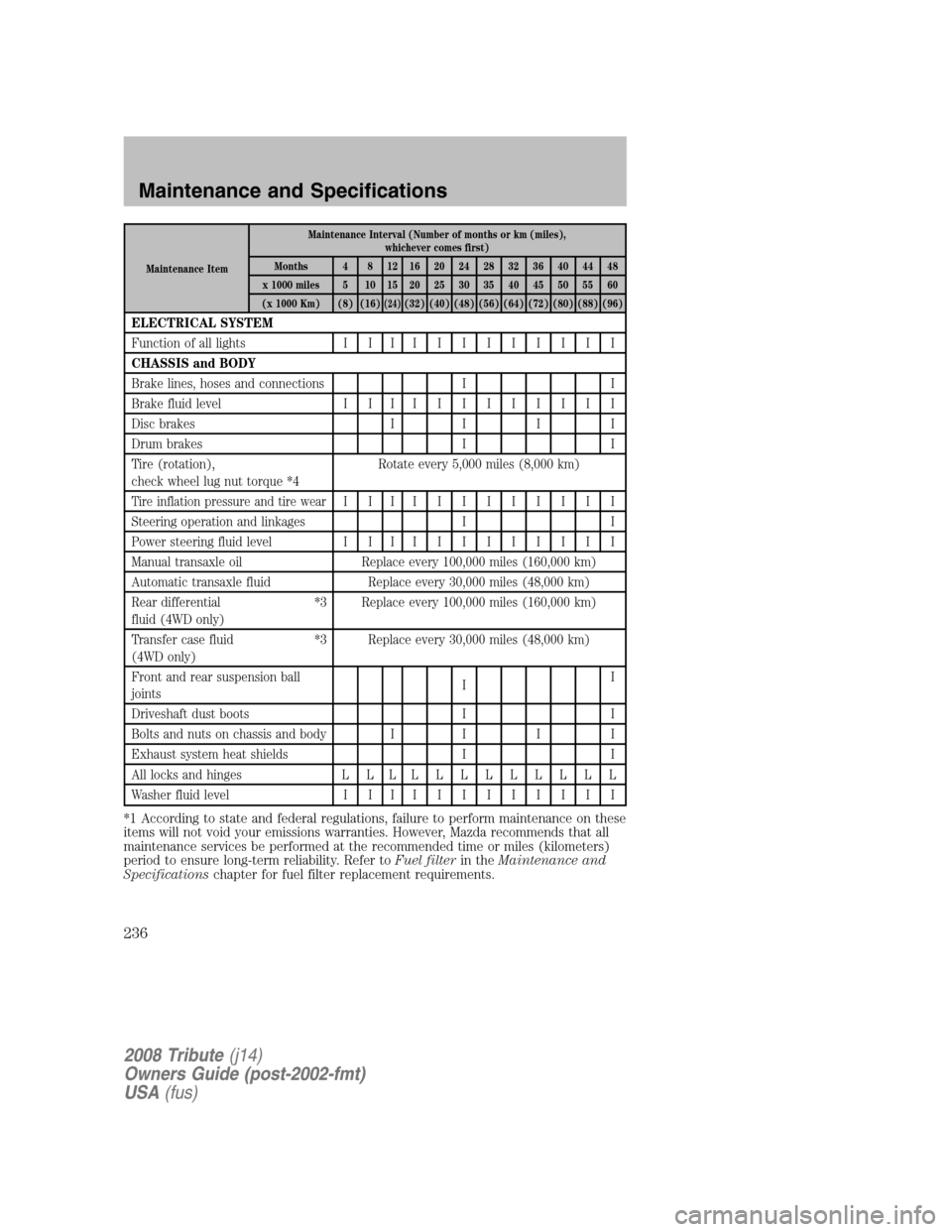
Maintenance Item Maintenance Interval (Number of months or km (miles),
whichever comes first)
Months 4 8 12 16 20 24 28 32 36 40 44 48
x 1000 miles 5 10 15 20 25 30 35 40 45 50 55 60
(x 1000 Km) (8) (16)
(24)(32) (40) (48) (56) (64) (72) (80) (88) (96)
ELECTRICAL SYSTEM
Function of all lights I I I IIIIIIIII
CHASSIS and BODY
Brake lines, hoses and connections I I
Brake fluid level I I I IIIIIIIII
Disc brakes I I I I
Drum brakes I I
Tire (rotation),
check wheel lug nut torque *4 Rotate every 5,000 miles (8,000 km)
Tire inflation pressure and tire wearIIIIIIIIIIII
Steering operation and linkages I I
Power steering fluid level I I I IIIIIIIII
Manual transaxle oil Replace every 100,000 miles (160,000 km)
Automatic transaxle fluid Replace every 30,000 miles (48,000 km)
Rear differential
fluid (4WD only) *3 Replace every 100,000 miles (160,000 km)
Transfer case fluid
(4WD only) *3 Replace every 30,000 miles (48,000 km)
Front and rear suspension ball
joints II
Driveshaft dust boots I I
Bolts and nuts on chassis and body I I I I
Exhaust system heat shields I I
All locks and hinges L L L LLLLLLLLL
Washer fluid level I I I IIIIIIIII
*1 According to state and federal regulations, failure to perform maintenance on these
items will not void your emissions warranties. However, Mazda recommends that all
maintenance services be performed at the recommended time or miles (kilometers)
period to ensure long-term reliability. Refer to Fuel filterin theMaintenance and
Specifications chapter for fuel filter replacement requirements.
2008 Tribute(j14)
Owners Guide (post-2002-fmt)
USA (fus)
Maintenance and Specifications
236